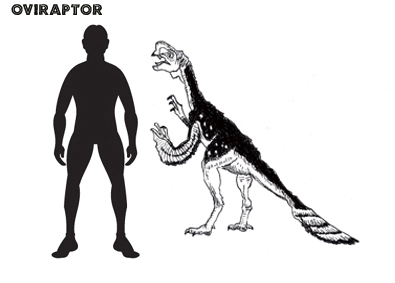Yuanyanglong bainian – A New Oviraptorosaur from Mongolia
Scientists have named a new species of oviraptorosaur from Inner Mongolia (China). This new theropod has been named Yuanyanglong bainian. The species name recognises that it is a hundred years since the naming of the first oviraptorosaur taxon. In 1924, Oviraptor philoceratops was named and formally described. Yuanyanglong is known from two fossil specimens recovered from the Lower Cretaceous Miaogou Formation. The fossils come from the Maortu locality in Chilantai, Inner Mongolia. Phylogenetic analysis suggests that it is a sister taxon to the clade formed by the Caenagathoidea and the Avimimidae. It was a small dinosaur standing less than a metre high.

A scale drawing of the recently described oviraptorosaur from Inner Mongolia Yuanyanglong bainian. Picture credit: Everything Dinosaur.
Picture credit: Everything Dinosaur
Yuanyanglong bainian
The research team, writing in the academic journal Cretaceous Research identified several unique autapomorphies in the fossilised bones. For example, the hindlimbs are proportionately elongated and they have fused lower segments. In addition, the ilium (part of the pelvic girdle) has a much reduced postacetabular process. This combination of anatomical traits is not known in other oviraptorosaurs, however, they are found in extant wading birds. Yuanyanglong may have lived close to bodies of water.
One of the specimens PV02476-2 consists of a partial and poorly preserved skull. However, the potential diet of this theropod can only be inferred at this time. Preserved gastroliths similar to those associated with another oviraptorosaur – Caudipteryx have been recovered. The research team have stated that preliminary observations indicate potential discrepancies in the digestion mode of early and late-diverging oviraptorosaurs.
The first part of the genus name is derived from “Yuanyang” the mandarin term for lovebirds (Aix galericulata). These birds form long bonds with their partners, a reference to the pair of skeletons found together. The second part of the genus name “long” is a transliteration of the Chinese word for dragon. The species or trivial name “bainian” translates as “one hundred years”, reflecting a hundred years since the naming of the first oviraptorosaur taxon Oviraptor philoceratops.

A scale drawing of a typical oviraptorosaur (O. philoceratops). The species name of Yuanyanglong bainian commemorates the centenary of the naming of the first oviraptorosaur. Picture credit: Everything Dinosaur.
Picture credit: Everything Dinosaur
Rare Dinosaur Fossils
The Maortu locality in Chilantai, western Inner Mongolia has produced other vertebrate fossil remains. However, dinosaur fossils are rare. Some, as yet, undescribed sauropod remains have been reported. In addition, three dinosaur taxa are known from this area. A theropod has been described (Shaochilong maortuensis), along with a hadrosaurid Probactrosaurus gobiensis. In addition, fossils of an armoured dinosaur have been found. Gobisaurus domoculus was named and formally described in 2001 (Vickaryous et al). Regarded as a member of the Ankylosauridae family Gobisaurus was a large, robust animal. It may have been over six metres in length and weighed in excess of three tonnes.
A spokesperson from Everything Dinosaur commented that further analysis of vertebrate fossil remains from the Maortu locality would likely result in the announcing of new dinosaur taxa.
To read an article from 2016 about the discovery of a oviraptorosaur from southern China (Tongtianlong limosus) that provided new insights into oviraptorosaur radiation: A Fresh Perspective on Oviraptorosaur Radiation.
The scientific paper “A new oviraptorosaur from the Lower Cretaceous Miaogou Formation of western Inner Mongolia, China” by Mingze Hao, Zhiyu Li, Zhili Wang, Shuqiong Wang, Feimin Ma, Qinggele, J. Logan King, Rui Pei, Qi Zhao and Xing Xu published in the journal Cretaceous Research.
Visit the award-winning Everything Dinosaur website: Dinosaur Toys and Figures.

